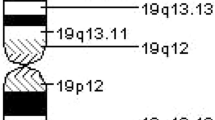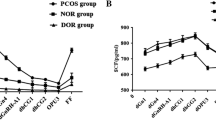Abstract
Purpose
This study aimed to analyze the hormone profiles, to detect the rate of hyperandrogenemia and to investigate the potential effect of Mayer–Rokitansky–Küster–Hauser syndrome (MRKHS) on ovarian reserve, as reflected by the serum Anti-Mullerian hormone (AMH) levels. Clinical implications were analyzed by including our own experiences with three patients after ovarian stimulation in preparation for uterus transplantation.
Methods
Serum samples of 100 patients with MRKHS (50 patients with MRKHS type 1 and 50 with type 2) were analyzed and compared to 50 individually age-matched healthy controls. Blood samples for hormone analyses were collected routinely during the clinical visit.
Results
The mean age was 20.0 years for MRKHS type 1, MRKHS type 2 and healthy controls. Compared to healthy controls, there was no significant difference in AMH values in the MRKH patients. As shown in previous studies, the proportion of hyperandrogenemia without clinical symptoms was significantly higher in MRKHS type 1 (52%; p < 0.001) and type 2 (56%; p < 0.001) patients when compared to age-matched controls. In preparation for uterus transplantation, three patients were stimulated with FSH/hMG for mean 14.2 days and the mean number of aspirated oocytes was 13.2 (3–22), while 8.3 (2–10) oocytes could be fertilized and cryopreserved. The mean fertilization rate was 51.2% (30–67%).
Conclusion
The rate of hyperandrogenemia was significantly higher in MRKH patients compared to healthy age-matched controls. Though, ovarian reserve (AMH level) was not reduced compared to controls. Future studies are needed to identify optimal ovarian stimulation protocols as well as to implement a systematic multicenter reporting system.


Similar content being viewed by others
References
Aittomaki K, Eroila H, Kajanoja P (2001) A population-based study of the incidence of Mullerian aplasia in Finland. Fertil Steril 76:624–625
Anonymous (2016) Deutsches IVF Register (DIR), Jahrbuch 2015. modif. Reprint from J Reproduktionsmed Endokrinol 13
Balen A (2004) The pathophysiology of polycystic ovary syndrome: trying to understand PCOS and its endocrinology. Best Pract Res Clin Obstet Gynaecol 18:685–706
Bernardini L, Gimelli S, Gervasini C et al (2009) Recurrent microdeletion at 17q12 as a cause of Mayer-Rokitansky-Kuster-Hauser (MRKH) syndrome: two case reports. Orphanet J Rare Dis 4:25
Biason-Lauber A, De Filippo G, Konrad D et al (2007) WNT4 deficiency–a clinical phenotype distinct from the classic Mayer-Rokitansky-Kuster-Hauser syndrome: a case report. Hum Reprod 22:224–229
Biason-Lauber A, Konrad D, Navratil F et al (2004) A WNT4 mutation associated with Mullerian-duct regression and virilization in a 46, XX woman. N Engl J Med 351:792–798
Brannstrom M, Bokstrom H, Dahm-Kahler P et al (2016) One uterus bridging three generations: first live birth after mother-to-daughter uterus transplantation. Fertil Steril 106:261–266
Brannstrom M, Johannesson L, Bokstrom H et al (2015) Livebirth after uterus transplantation. Lancet 385:607–616
Brannstrom M, Johannesson L, Bokstrom H et al (2015) Livebirth after uterus transplantation. Lancet 385:607–616
Brucker SY, Gegusch M, Zubke W et al (2008) Neovagina creation in vaginal agenesis: development of a new laparoscopic Vecchietti-based procedure and optimized instruments in a prospective comparative interventional study in 101 patients. Fertil Steril 90:1940–1952
Carranza-Lira S, Forbin K, Martinez-Chequer JC (1999) Rokitansky syndrome and MURCS association—clinical features and basis for diagnosis. Int J Fertil Womens Med 44:250–255
Chen MJ, Wei SY, Yang WS et al (2015) Concurrent exome-targeted next-generation sequencing and single nucleotide polymorphism array to identify the causative genetic aberrations of isolated Mayer-Rokitansky-Kuster-Hauser syndrome. Hum Reprod 30:1732–1742
Cicinelli E, Einer-Jensen N, Cignarelli M et al (2004) Preferential transfer of endogenous ovarian steroid hormones to the uterus during both the follicular and luteal phases. Hum Reprod 19:2001–2004
Folch M, Pigem I, Konje JC (2000) Mullerian agenesis: etiology, diagnosis, and management. Obstet Gynecol Surv 55:644–649
Fraser IS, Baird DT, Hobson BM et al (1973) Cyclical ovarian function in women with congenital absence of the uterus and vagina. J Clin Endocrinol Metab 36:634–637
Friedler S, Grin L, Liberti G et al (2016) The reproductive potential of patients with Mayer-Rokitansky-Kuster-Hauser syndrome using gestational surrogacy: a systematic review. Reprod Biomed Online 32:54–61
Hall-Craggs MA, Kirkham A, Creighton SM (2013) Renal and urological abnormalities occurring with Mullerian anomalies. J Pediatr Urol 9:27–32
Hansen KR, Knowlton NS, Thyer AC et al (2008) A new model of reproductive aging: the decline in ovarian non-growing follicle number from birth to menopause. Hum Reprod 23:699–708
Herlin M, Bjorn AM, Rasmussen M et al (2016) Prevalence and patient characteristics of Mayer-Rokitansky-Kuster-Hauser syndrome: a nationwide registry-based study. Hum Reprod 31:2384–2390
Jb B (1959) Preliminary observation on urinary oestrogen excretion in certain gynaecological disorders. J Obstet Gynaecol Br Commonw 66:177–211
Kallio S, Puurunen J, Ruokonen A et al (2013) Antimullerian hormone levels decrease in women using combined contraception independently of administration route. Fertil Steril 99:1305–1310
Kim JY, Tfayli H, Michaliszyn SF et al (2017) Anti-Mullerian Hormone in Obese Adolescent Girls With Polycystic Ovary Syndrome. J Adolesc Health 60:333–339
Ledig S, Schippert C, Strick R et al (2011) Recurrent aberrations identified by array-CGH in patients with Mayer-Rokitansky-Kuster-Hauser syndrome. Fertil Steril 95:1589–1594
Morcel K, Watrin T, Pasquier L et al (2011) Utero-vaginal aplasia (Mayer-Rokitansky-Kuster-Hauser syndrome) associated with deletions in known DiGeorge or DiGeorge-like loci. Orphanet J Rare Dis 6:9
Nik-Zainal S, Strick R, Storer M et al (2011) High incidence of recurrent copy number variants in patients with isolated and syndromic Mullerian aplasia. J Med Genet 48:197–204
Oppelt P, Renner SP, Kellermann A et al (2006) Clinical aspects of Mayer-Rokitansky-Kuester-Hauser syndrome: recommendations for clinical diagnosis and staging. Hum Reprod 21:792–797
Oppelt P, Strissel PL, Kellermann A et al (2005) DNA sequence variations of the entire anti-Mullerian hormone (AMH) gene promoter and AMH protein expression in patients with the Mayer-Rokitanski-Kuster-Hauser syndrome. Hum Reprod 20:149–157
Oppelt PG, Mueller A, Stephan L et al. (2017) Hyperandrogenemia and high prolactin in congenital utero-vaginal aplasia patients. Reproduction
Ozekinci M, Erman Akar M, Senol Y et al (2015) Comparison of markers of ovarian reserve between patients with complete mullerian agenesis and age-matched fertile and infertile controls. Fertil Steril 104:176–179
Philibert P, Biason-Lauber A, Gueorguieva I et al (2011) Molecular analysis of WNT4 gene in four adolescent girls with mullerian duct abnormality and hyperandrogenism (atypical Mayer-Rokitansky-Kuster-Hauser syndrome). Fertil Steril 95:2683–2686
Philibert P, Biason-Lauber A, Rouzier R et al (2008) Identification and functional analysis of a new WNT4 gene mutation among 28 adolescent girls with primary amenorrhea and mullerian duct abnormalities: a French collaborative study. J Clin Endocrinol Metab 93:895–900
Rall K, Conzelmann G, Schaffeler N et al (2014) Acne and PCOS are less frequent in women with Mayer-Rokitansky-Kuster-Hauser syndrome despite a high rate of hyperandrogenemia: a cross-sectional study. Reprod Biol Endocrinol 12:23
Raziel A, Friedler S, Gidoni Y et al (2012) Surrogate in vitro fertilization outcome in typical and atypical forms of Mayer-Rokitansky-Kuster-Hauser syndrome. Hum Reprod 27:126–130
Sandbacka M, Halttunen M, Jokimaa V et al (2011) Evaluation of SHOX copy number variations in patients with Mullerian aplasia. Orphanet J Rare Dis 6:53
Sowers M, Mcconnell D, Gast K et al (2010) Anti-Mullerian hormone and inhibin B variability during normal menstrual cycles. Fertil Steril 94:1482–1486
Strissel PL, Oppelt P, Cupisti S et al (2009) Assessment of pituitary and steroid hormones and members of the TGF-beta superfamily for ovarian function in patients with congenital uterus and vaginal aplasia (MRKH syndrome). Horm Metab Res 41:408–413
Strubbe EH, Willemsen WN, Lemmens JA et al (1993) Mayer-Rokitansky-Kuster-Hauser syndrome: distinction between two forms based on excretory urographic, sonographic, and laparoscopic findings. AJR Am J Roentgenol 160:331–334
Sultan C, Biason-Lauber A, Philibert P (2009) Mayer-Rokitansky-Kuster-Hauser syndrome: recent clinical and genetic findings. Gynecol Endocrinol 25:8–11
Ugur M, Karakaya S, Zorlu G et al (1995) Polycystic ovaries in association with mullerian anomalies. Eur J Obstet Gynecol Reprod Biol 62:57–59
Verma AK, Rajbhar S, Mishra J et al (2016) Anti-mullerian hormone: a marker of ovarian reserve and its association with polycystic ovarian syndrome. J Clin Diagn Res 10:QC10–QC12
Visser JA, De Jong FH, Laven JS et al (2006) Anti-Mullerian hormone: a new marker for ovarian function. Reproduction 131:1–9
Acknowledgements
The authors thank all patients who participated in this study and Sabine Hofmeister for her help with the biobank. The present data/results were part of the MD thesis work of Ludmila Jurow (L. Jurow, unpublished thesis work). She fully agreed to include the present data.
Funding
There was no funding for this study.
Author information
Authors and Affiliations
Contributions
MH: protocol/project development, data analysis, manuscript writing/editing. KR: protocol/project development, data collection, data analysis, manuscript writing/editing. LJ: data collection, data analysis. AP: hormone analyses. BS: age-matching, data analysis (statistics). FAT: critical revision of manuscript. MH: critical revision of manuscript. HS: archiving of blood samples, critical revision of manuscript. SYB: data collection, critical revision of manuscript.
Corresponding author
Ethics declarations
Conflict of interest
The authors state that there are no conflicts of interest.
Rights and permissions
About this article
Cite this article
Henes, M., Jurow, L., Peter, A. et al. Hyperandrogenemia and ovarian reserve in patients with Mayer–Rokitansky–Küster–Hauser syndrome type 1 and 2: potential influences on ovarian stimulation. Arch Gynecol Obstet 297, 513–520 (2018). https://doi.org/10.1007/s00404-017-4596-1
Received:
Accepted:
Published:
Issue Date:
DOI: https://doi.org/10.1007/s00404-017-4596-1




